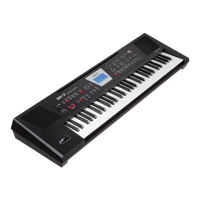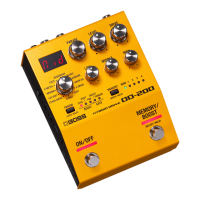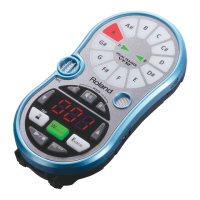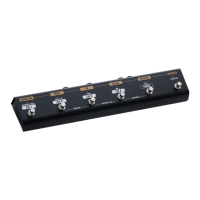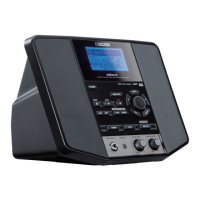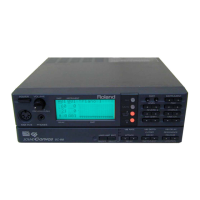Details about the ‘Wizard Connection’ categories
Backing Module BK-7m
r
25
allowing you to control which notes you play on your
guitar should be recognized by the BK-7m’s Arranger
(see p. 65).
The “Wizard Connection” function sets the BK-7m’s
chord recognition to “Guitarist” (irrespective of
whether or not the [SPLIT] button lights) and acti-
vates the “Split” and “Arranger Type” filters of the
“Performance Hold” function to ensure that those
settings don’t change when you recall another Per-
formance memory or One Touch setting.
NOTE
Roland recommends leaving the [SPLIT] button off while
you are using this setting.
‘DIGITAL ORGAN’ category
Select “CHURCH ORGAN1” if your organ transmits on
MIDI channels 12, 13 and 14.
•The only step will be “Wizard Settings will be
saved” (see step (7) on page 22).
Select “CHURCH ORGAN2” if your organ transmits on
MIDI channels 1, 2 and 3.
•The only step will be “Wizard Settings will be
saved” (see step (7) on page 22).
The notes played on Manual II (Swell) and Manual I
(Great) as well as the bass pedal board control the
BK-7m’s real-time parts UP1, UP2, LWR and MBS. The
chords played on Manual I (Great) are also used by
the Arranger’s NTA section (for chord recognition).
The “Wizard Connection” function sets the BK-7m’s
chord recognition to “Intelligent” (irrespective of
whether or not the [SPLIT] button lights) and acti-
vates the “Split” and “Arranger Type” filters of the
“Performance Hold” function to ensure that those
settings don’t change when you recall another Per-
formance memory or One Touch setting.
Select “ELECTRONIC ORGAN” if your organ transmits
on other MIDI channels than the ones selected for
“CHURCH ORGAN1” and “CHURCH ORGAN2”. In this
mode, the BK-7m’s wizard detects the MIDI channel
numbers to be assigned to UP1, UP2, LWR and MBS. The
chords you play on the lower manual (LWR) are also
used by the BK-7m’s Arranger.
Here, there are four steps:
•“Play a note on Upper section” ‰ Press any key on
the upper manual to specify the MIDI channel for the
UP1 and UP2 parts.
•“Play a note on Lower section” ‰ Press any key on
the lower manual to specify the MIDI channel for the
LWR part.
•“Play a note on Pedal section” ‰ Press any pedal-
board key to specify the MIDI channel for the MBS
part.
•“Wizard Settings will be saved” (see step (7) on
page 22).
The “Wizard Connection” function sets the BK-7m’s
chord recognition to “Intelligent” (irrespective of
whether or not the [SPLIT] button lights) and acti-
vates the “Split” and “Arranger Type” filters of the
“Performance Hold” function to ensure that those
settings don’t change when you recall another Per-
formance memory or One Touch setting.
NOTE
Roland recommends leaving the [SPLIT] button off while
you are using the “MULTI CHANNEL” setting.
NOTE
Roland recommends leaving the [SPLIT] button off while
you are using one of these settings.
‘COMPUTER/SEQUENCER’ category
This “Wizard Connection” option configures the BK-7m
for use as a multitimbral sound module that is con-
trolled by a software sequencer running on your com-
puter.
•The only step will be “Wizard Settings will be
saved” (see step (7) on page 22).
NOTE
This option disables MIDI data reception by the BK-7m’s
Arranger and real-time parts, because all 16 MIDI channels are
already taken.
BK-7m_UK.book Page 25 Tuesday, January 4, 2011 9:25 AM

